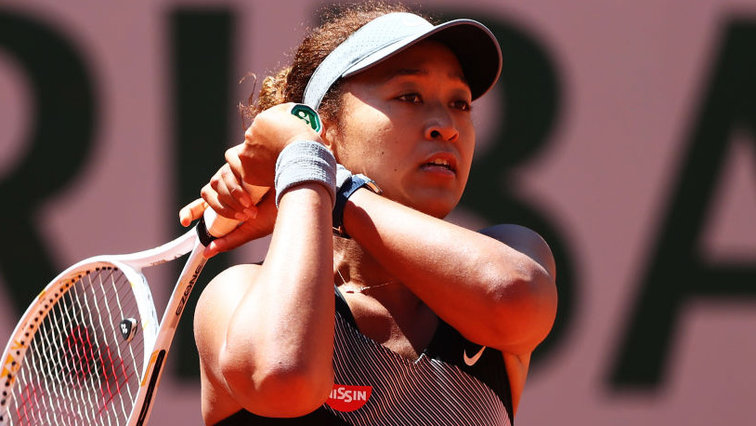French Open: The two faces of Naomi Osaka - task as the last exclamation mark
With her withdrawal from the French Open 2021, Naomi Osaka has ended the discussions about her press boycott for the time being. But the topic is far from over.
by Jörg Allmeroth
last edit:
Jun 01, 2021, 06:54 pm

There would have been enough to talk about on this first Monday of the French Open 2021 tournament: the Grand Slam comeback of a certain Roger Federer , the first night performance in Roland Garros history with the legendary Serena Williams. But it all faded on the evening of May 31st, just as Naomi Osaka announced her memorable retirement from this major competition - the most talented, successful player of the new generation of tennis.
It was a paradoxical final exclamation point behind a story that began with a threatened media boycott of Osaka. This has since continued with a $ 15,000 fine for Osaka because, as announced, it skipped its first mandatory press conference. Which then reached a dramatic first moment when she was threatened with disqualification in the name of all four Grand Slam tournaments. And which then ended with an impressive statement in which the 23-year-old Japanese gave painful insights into her attacked, unstable psyche. Since 2018, she has been struggling with longer phases of depression and suffering from phobias in public, explained the four-time Grand Slam winner, now it is best for the tournament and for herself, “if I withdraw, so that everyone can can concentrate on the current events in Paris again.
Navratilova and Shriver show understanding
When Osaka will return to a tennis court was one of the unanswered questions this unprecedented process left. However, appearances this summer, including in Berlin or Wimbledon, seem rather uncertain. “You won't just get well again if you have these problems,” said Boris Becker, who was once thrown into the big tennis machine at the age of 17, “I'm a little worried about Naomi.” Man must now give her "enough time" to find stability and get healthy, explained the former exceptional player Martina Navratilova: "One thing is clear: your problems go much deeper than it seemed." The difficulties in dealing with the media are apparently only part of the truth, said Pam Shriver, the former head of the WTA players' association.
Of course, tennis professionals just like professional athletes from other disciplines experience unpleasant, bitter moments when they have to face the media. However, there is usually heavier psychological ballast on the actors: The pressure of expectation in their own family environment, who would not remember cases like those of Jennifer Capriati or Jelena Dokic. In cases of domestic violence, often with not so prominent names. In addition, there is often financial pressure, pressure from sponsors who want to see results, and contracts are linked to successes. And then there is also the deadline pressure in the traveling circus, the treadmill of the tour, the months of rushing around across the continents and time zones. It is a tough ride that makes many players physically and then mentally ill. Many fail because of this system, especially in Germany there have recently been talented female players who can no longer cope with the extreme challenges. And who, incidentally, were treated quite antisocially on social media, insulted as failures.
The Naomi Osaka case is even more difficult. Because there are definitely two faces of this extraordinary athlete in public. On the one hand there is the prominently marketed and highest-earning sportswoman who has been posing for months on the covers of fashion, sports or social magazines, who expresses herself self-determined and courageously on topics of the time and last year also a prominent voice of the Black Lives Matter Movement was. On the other hand, there is the face of a tennis player who just wants to play tennis and does not feel comfortable when she is in the spotlight in any way in her very own professional scene. In her farewell letter on Monday, the Japanese also addressed these social fears and recalled her typical appearance - such as the headphones that she always wears to block out the outside world, so to speak.
Criticism of Osaka's management
She also remembered the traumatic experience of 2018, the US Open victory against Serena Williams, which was covered by the outbursts of her opponent. Dissolved in tears, Osaka stood on the podium at the time, in their greatest triumph to date. "After that, I had a hard time," Osaka said in her Paris declaration of withdrawal. Before the French Open, she felt fearful and hurt again, so she wanted to avoid the difficult press conferences as a preventive measure. However, the timing and the message were "not ideal and clear enough" last week.
Not clear enough for the organizers of the French Open and the rest of the Grand Slam competitions, which would certainly have spared Osaka the harsh sanctions threats with more transparency and discreet communication. Behind closed doors, representatives of the French association FFT harshly criticized Osaka's management, which did not even respond to offers for talks after the first refused press conference appearance. "It almost looked as if a certain escalation was wanted here," explained a top official, "so that we should stand there as villains." As is so often the case in tennis, this Osaka story is also a story of the "lack of communication" of those involved, noted the "New York Times".
